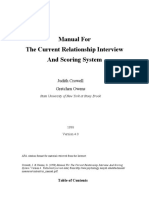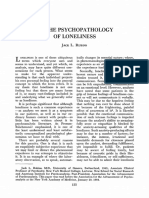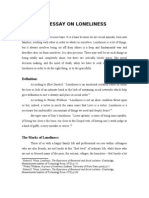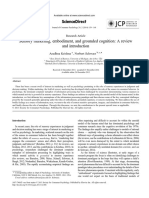The Study of Loneliness
The Study of Loneliness
Uploaded by
mayday6890Copyright:
Available Formats
The Study of Loneliness
The Study of Loneliness
Uploaded by
mayday6890Original Description:
Copyright
Available Formats
Share this document
Did you find this document useful?
Is this content inappropriate?
Copyright:
Available Formats
The Study of Loneliness
The Study of Loneliness
Uploaded by
mayday6890Copyright:
Available Formats
~
=
~
The Study
of Loneliness
Loneliness is a condition that is widely distributed and se-
verely distressing. Yet only a handful of psychiatrists, psychol-
ogists, and sociologists have studied the ordinary loneliness of
ordinary people. Sullivan, the great American psychiatrist, is
among the very few who have done so and among the very
few in any of the social sciences who have attempted a des-
cription of the symptomatology of loneliness. His description
is brief and sketchy, but nevertheless notably perceptive. In
particular he commented on the " driving force" of loneli-
ness- a force great enough, he pointed out, to cause people
who were normally painfully shy to aggressively seek social
activity . He concluded that " The fact that loneliness will lead
to integrations in the face of severe anxiety automatically
means that loneliness in itself is more terrible than anxiety." 1
Others who have observed the pressures under which the
lonely seem to act by and large have agreed with Sullivan's
appraisal.2
Why, then, has there been so little research on loneliness?
Loneliness is much more often commented on by songwriters
than by social scientists. One psychiatrist has suggested that
we neglect loneliness because we have no theory with which to
begin to cope with its manifestations .3 There may be some
10 THE STUDY OF LONELINESS
merit in this position; scientific attention may be directed in
part by the emphases of theory and the established preoccu-
pations of the field. But Frieda Fromm-Reichmann noted
that at least one reason that we have no very good theory
about loneliness is that we have studied it so little . She sug -
gested that the absence of attention to loneliness was to be ex-
plained not by the challenge loneliness presented to under-
standing but rather by the threat it presented to well-being.
She said that loneliness is " such a painful , frightening experi-
ence that people will do practically everything to avoid it ." 4
Fromm-Reichmann's explanation is appealing but seems
not to go far enough . There has for some time now been ac-
tive research interest in the sometimes excruciatingly painful
phenomena of grief and the intensely anxiety-provoking phe-
nomena of dying,5 and loneliness would not seem to be more
frightening than these conditions. There would seem to be
some additional quality in loneliness that leads to its neglect.
. Many of us severely underestimate our own past experi-
ence with loneliness and as a result underestimate the role it
has played in the lives of others. The observation that times
of loneliness are later difficult to recall has been made by both
Sullivan and Fromm - Reichmann . Sullivan believed that
loneliness was an experience so different from the ordinary
that its intensity could later not be entirely credited. He said
it was " an experience which has been so terrible that it prac-
tically baffles clear recall." 6 Fromm-Reichmann believed that
there was active rejection of the memory of loneliness, and not
simply passive inability to recall. She believed that many of
those who had once been lonely were aware that memory of
that state would be threatening to their current well-being.
11
THE STUDY OF LONELINESS
She said, " It is so frightening and uncanny in character that
they [those who have once suffered loneliness] try to dissoci -
ate the memory of what it was like and even the fear of it ." 7
I have occasionally asked individuals who were not at the
moment lonely to recall for me times when they had been. If
I knew that a year or so earlier they had moved into a new
community where they had had no friends, or that until the
last few months they had been without an intimate , I pressed
them to rememher how they had felt during these periods of
relational insufficiency. More than once I have been told
something like, " Yes, I suppose I was lonely. But I wasn' t
myself then." I think this is a most suggestive response. It im-
plies that an individual when lonely maintains an organiza-
tion of emotions , self -definitions , and definitions of his or her
relations to others, which is quite different from the one he
maintains when not lonely . Asked at a time when he is not
lonely to remember back to when he was lonely, he may pro-
test t4at the person he is at the moment has never been lonely
and that in the lonely past " I wasn' t myself." The self asso-
ciated with the absence of loneliness is a different one from
the self associated with loneliness : it is more engaged by a
range of interests , more confident , more secure , more self -
satisfied. To someone in this state the earlier lonely self-
tense , restless , unable to concentrate , driven - must seem an
aberration .
As an implication of the foregoing we might expect that
those who are not at the moment lonely will have litde em-
pathy for those who are, even if in the recent past they had
been lonely themselves. If they had earlier been lonely, they
now have no access to the self that experienced the loneliness;
12 THE STUDY OF LONELINESS
furthermore , they very likely prefer that things remain that
way . In consequence they are likely to respond to those who
are currently lonely with absence of understanding and per -
haps irritation .
Professionals in research and treatment , if they have dealt
with their own past experiences of loneliness in this way ,
might also prefer not to disturb their current emotional ar -
rangements . To maintain their current feelings of well -being ,
they too might be impatient with the problem of loneliness.
They might be willing to consider loneliness in an exotic form
- the loneliness of the mentally ill or of the Arctic explorer or
the alienation of marginal man . But they would be made un-
comfortable by the loneliness that is potential in the everyday
life of everyone .
The frequency and intensity of loneliness are not only un-
derestimated but the lonely themselves tend to be disparaged .
I t seems easy to blame their loneliness on their frailties and to
a~cept this fault -finding as explanation . Our image of the
lonely often casts them as justifiably rejected : as people who
are unattractive , shy, intentionally reclusive , undignified in
their complaints , self-absorbed , self-pitying . We may go fur -
ther and suppose that chronic loneliness must to some extent
be chosen. Surely , we might argue, it is easy enough to be ac-
ceptable to others . All that is necessary is to be pleasant , out -
going , interested in the others rather than in oneself . Why
can' t the lonely change ? They must find a perverse gratifica -
tion in loneliness ; perhaps loneliness, despite its pain , permits
them to continue a self-protective isolation or provides them
with an emotional handicap that forces handouts of pity from
those with whom they interact . Thoughts like these may jus-
13 THE STUDY OF LONELINESS
tify professional as well as lay impatience with the lonely . 8
There may be some small merit in this characterological
theory of loneliness , as we shall later note . But there is also
implicit in it a rationalization for rejection of the lonely and
of the problem of loneliness . Each is pictured as easy to un -
derstand : the lonely are people who move against others or
away from others and of course they then feel bad because
they are alon ~ . Along these lines , advice for the lonely would
seem obvious : be pleasant , outgoing , interested in others ;
meet people ; become part of things . If the lonely cannot be -
have in these ways , then they ought to enter psychotherapy ,
change , learn to be more outgoing .
Yet for those who suffer from loneliness , advice of this sort
often seems oddly beside the point . There may seem to them
to be something in loneliness that is " uncanny , " to use
Fromm - Reichmann ' s word . It is peculiarly insistent ; no mat -
ter how much those who are lonely would like to shake it off ,
no matter how much they may berate themselves for permit -
ting it to overcome them , they find themselves possessed by it .
No matter how devotedly they may count their other bless -
ings , no matter how determined they may be to put their
minds to other things , the loneliness remains , an almost eerie
affliction of their spirits .
Loneliness is not simply a desire for company , any com -
pany ; rather it yields only to very specific forms of relation -
ship . Loneliness is often uninterrupted by social activity ; the
social activity may feel " out there , " in no way engaging the
individual ' s emotions . It can even make matters worse . How -
ever the responsiveness of loneliness to just the right sort of
relationship with others is absolutely remarkable . Given the
LONELINESS AND OTHER CONDITIONS
What do we mean by loneliness? The word has been used to
describe a number of different conditions , even as other
words , including depression and grief , have been used to des-
cribe conditions that would -seem to have some affinity with
loneliness.
Sometimes the term loneliness has been used to describe a
not at all disagreeable condition in which a sense of one' s
separateness from others offers " a way back to oneself ." 9
This sort of loneliness refers to a time in which one is not
only alone but also able to use one' s aloneness to recognize
with awesome clarity both one' s ineradicable separateness
from all else and one' s fundamental connectedness. It is a
ti ~ e of almost excruciating awareness in which one sees
clearly the fundamental facts of one' s small but unique place
in the ultimate scheme, after which one can recognize one' s
true self and begin to be that true self .
I do not doubt that this experience occurs : that there are
times when being alone gives rise to this awesome awareness
of oneself and one' s world . Some individuals may be able to
transmute the intense discomfort of ordinary loneliness into
this exalted state. But the state, even if it begins in ordinary
loneliness, is different from the experience described to my
colleagues and me in our studies of loneliness in ordinary life .
14 THE STUDY OF LONELINESS
establishment of these relationships , loneliness will vanish ab-
ruptly and without trace , as though it never had existed .
There is no gradual recovery , no getting over it bit by bit .
When it ends, it ends suddenly ; one was lonely , one is not any
more .
.
15 THE STUDY OF LONELINESS
The loneliness we have been told of is gnawing rather than
ennobling , a chronic distress without redeeming features .
Another condition that may be described as loneliness is
unwanted individuation : being separated off from parents
and others to fend for oneself, not just in the sense of becom-
ing responsible for oneself but also in the sense of being and
developing as a separate self .1O Again , although this condition
may be related to what most of us experience as loneliness, it
does not appear to be quite the same thing . Nor is the existen-
tialist notion of the ultimate loneliness of each of us in decid -
ing and evaluating our course in life the same thing .
The condition discussed in this book is ; he one Sullivan de-
scribed as " the exceedingly unpleasant and driving experi -
ence connected with inadequate discharge of the need for
human intimacy ." 11 This common , if perplexing , condition
is the only one we have had reported to us in our studies of
loneliness in ordinary life , excerpts from which are presented
later in this book . The other forms of loneliness I have just
noted would appear from our studies to be fairly rare states.
They are not the loneliness experienced by those who are be-
reaved or divorced or uprooted .
Ordinary loneliness is uniformly distressing . It may be use-
ful to distinguish it from other forms of distress. To begin
with , it is different from what is usually described as depres-
sion. In loneliness there is a drive to rid oneself of one' s dis-
tress by integrating a new relationship or regaining a lost one;
in depression there is instead a surrender to it . The lonely are
driven to find others, and if they find the right others, they
change and are no longer lonely . The depressed are often un-
willing to impose their unhappiness on others ; in any event
16
.
THE STUDY OF LONELINESS
their feelings cannot be reached by relationships , old or new.12
Loneliness is also distinct from grief . The term grief may
be used in a number of ways but perhaps is best used to des-
cribe the syndrome of shock, protest , anger , and painful , sear-
ing sadness, which is produced by traumatic 10SS .13 Loneliness
often is a component of this syndrome ; however it is a reac-
tion to the absence of the cherished figure rather than to the
experience of its loss. We would expect every other aspect of
grief to subside as time goes on = shock might be expected to
disappear , protest to be muted , anger and sadness to dimin -
ish. But loneliness, so long as no new relationship is formed
to replace what has been lost , might be expected to continue .
ORDINARY LONELINESS
Research on the nature of ordinary loneliness is as yet frag -
mentary . Surveys have generated useful statistics regarding
the proportions of individuals in various demographic cate-
gories who declare themselves to be lonely , but to my know -
ledge none has investigated the reasons for loneliness, the
conditions under which loneliness occurs, or the subjective
experience of loneliness . We do have, however , case studies
of individuals living in conditions likely to give rise to lone-
liness. These describe individuals who have been widowed ,
who have separated from or divorced a spouse, who have en-
tered into a new community , or who have suffered the loss
of intimates which is one of the afflictions of advanced age.
On the basis of these studies we can develop some initial un -
derstandings of loneliness .
The dictionary definition of loneliness is not very useful .
This is how Webster ' s defines the term : ' c. . . A state of de-
17
THE STUDY OF LONELINESS
jection or grief caused by the condition of being alone . . ." 14
To be sure, no one who is lonely would consider himself
happy, and to this extent Webster's is correct in associating
loneliness with dejection and grief . But the definition is mis-
leading in asserting that loneliness is dejection or grief ; lone-
liness is quite different from these conditions, as has been
noted earlier. More important , the definition is misleading in
asserting that loneliness is " caused by the condition of being
alone." On this point the case study materials we have col-
lected are unambiguous. Loneliness is caused not by being
alone but by being without some definite needed relationship
or set of relationships.
Only those who are not lonely suppose that loneliness can
be cured merely by ending aloneness. Not only is random so-
ciability no antidote to loneliness, but under some circum-
stances it can exacerbate it ; someone who is not married and
in consequence feels outside the society of settled family life
may find that being with married couples only intensifies his
or her feelings of marginality , of having no valid place. A
widower, some of whose experiences are described in a later
chapter, said about an evening with married friends, " It 's
like being a fifth wheel."
Loneliness appears always to be a response to the absence
of some particular type of relationship or, more accurately,
a response to the absence of some particular relational pro-
vision . In many instances it is a response to the absence of the
provisions of a close, indeed intimate , attachment . It may also
be a response to the absence of the provisions of meaningful
friendships, collegial relationships, or other linkages to a co-
herent community. These seem to be the most common forms
18 THE STUDY OF LONELINESS
of loneliness, but there may be others as well ; conceivably ,
some parents whose children have left home may feel the ab-
sence of the distinctive provisions of the relationship one
maintains with those one has nurtured . And at Christmas
time , especially , many of those who are unable to join with
kin feel distressed by the separation , for Christmas is a time
of reaffirmation by kin of their fundamental commitment to
one another .15
All these instances of conditions giving rise to loneliness
support the presumption that loneliness is a response to re-
lational deficit . Although each syndrome of response to spe-
cific relational deficit appears to be unique in some respects,
each appears to include certain common symptoms , just as
any infection may have both unique symptoms by which it
can be distinguished from other infections and also shared
symptoms such as fever . All loneliness syndromes would seem
to give rise to yearning for the relationship - an intimacy , a
fr ~endship , a relationship with kin - that would provide
whatever is at the moment insufficient . All may be able to
produce the driving restlessness of which Sullivan spoke.
And all may induce impatience or irritability with relation -
ships that seem to impede access to the desired relationship .
Insofar as those symptoms seem to be part of any experience
of loneliness one may speak of " loneline.~s" as a single con-
dition .
Different forms of loneliness are, however , responsive to
different remedies. We have repeatedly found in our studies
that a form of loneliness that appears in the absence of a close
emotional attachment , which we characterize as " the loneli -
ness of emotional isolation ," can only be remedied by the in -
19 THE STUDY OF LONELINESS
ship , one which in some ways makes the same provisions as
the marriage they no longer have, they remain lonely .
Conversely , we have found that the form of loneliness asso-
ciated with the absence of an engaging social network - the
" loneliness of social isolation " - can be remedied only by
access to such a network . This was demonstrated for us in a
pilot study of couples who had moved to the Boston region
frolJl at least two states away .17 The wives in these couples
tended for a time to have " newcomer blues" ; they felt out of
place and unwanted in their new community and were deeply
homesick for their former one. Their husbands , no matter
how close the marriage , were of little help . The husbands did
not share their wives ' distress since they had entered a ready -
made community at their workplace . Furthermore , the hus-
bands ' attention and energies were absorbed by their efforts
to become established in their new jobs . But even when the
husbands did seem able in a limited way to understand and to
sympathize , the wives continued to be lonely for friends and
acquaintances who would share their interests as their hus-
bands did not . They wanted access to a network of women
tegration of another emotional attachment or the reintegra -
tion of the one that had been lost .1G Evidence that the lone-
liness of emotional isolation cannot be dissolved by entrance
into other sorts of relationships , perhaps especially new friend -
ships, is repeatedly rediscovered by new members of the Par -
ents Without Partners organization . New members often are
attracted to that organization because they are lonely and
hope membership will allay the loneliness . Within the organi -
zation they may form new friendships or take on new respon-
sibilities , but unless they also form a single intense relation -
20 THE STUDY OF LONELINESS
with whom they might establish and then discuss issues of
common concern : shopping , home management , the devel -
oping lives of their children and , of course, one another .
Though the newcomer wife might be content in her marriage ,
social isolation nevertheless made her painfully lonely , and
her loneliness ended only when she found an accepting - and
acceptable - community .
The complex of symptoms of the loneliness of emotional
isolation are in the main different from those of the loneliness
of social isolation , although there is in each the same driving
restlessness and the same yearning for the missing relational
provisions . The complex of symptoms associated with the
loneliness of emotional isolation is strongly reminiscent of the
distress of the small child who fears that he has been aban -
doned by his parents . On the other hand , the symptoms as-
sociated with the loneliness of social isolation are like the
boredom , feelings of exclusion , and feelings of marginality of
th ~ small child whose friends are all away . We might reason-
ably suspect that the loneliness states of adults are develop -
ments of the earlier childhood states. They may have been
modified by the new strengths and understandings of matur -
ation , but still they seem like the childhood syndromes in fun -
damental ways.
Many of the symptoms of the loneliness of emotional isola-
tion seem to stem from a re-experiencing of the anxiety pro -
duced by childhood abandonment . This is a central theme ,
and gives rise to a sense of pervasive apprehensiveness- one
of our respondents called it " a nameless fear " 18- that may
prevent concentration on reading or television and almost
21 THE STUDY OF LONELINESS
force the individual into some sort of motor activity as a
channel for his or her jumpiness . .
Associated with apprehensiveness is sometimes vigilence to
threat , a readiness to hear smmds in the night , which keeps
one tense, unable to relax enough to sleep. Often though ,
vigilence seems less to be directed to threat than to possible
remedy ; the individual is forever appraising others for their
potential as providers of the needed relationship , and forever
appraising situations in terms of their potential for making
the needed relationships available . The lonely individual ' s
perceptual and motivational energies are likely to become
organized in the service of finding remedies for his or her
loneliness .
Finally , those experiencing the loneliness of emotional iso-
lation are apt to experience a sense of utter aloneness, whether
or not the companionship of others is in fact accessible to
them . This sense of utter aloneness may be phrased in terms
of the absence of anyone else in the environment , in which
case the individuat may describe the immediately available
world as desolate, barren , or devoid of others ; or the sense of
utter aloneness may be phrased in terms of an empty inner
world , in which case the individual may say that he or she
feels empty , dead, or hollow .
Occasionally , the hyperalertness of the individual suffer -
ing from the loneliness of emotional isolation produces an
oversensitivity to minimal cues and a tendency to misinter -
pret or to exaggerate the hostile or affectionate intent of
others . This oversensitivity can make the individual seem to
be awkward or foolish .
22
.
THE STUDY OF LONELINESS
The dominant symptoms of the loneliness of social isola-
tion are different from these. Feelings of boredom or aimless-
ness, together with feelings of marginality , seem to be central
themes, rather than anxiety and emptiness . Boredom seems to
come about as the tasks that make up one' s daily routines ,
because they are inaccessible to the affirmation of others, lose
their meaning and begin to be simply busy work . The day' s
duties then are a burdensome ritual which one can hardly
persuade oneself to observe. Again there is restlessness and
difficulty in concentration , preventing the individual from
becoming engaged in a distraction such as a book or tele-
vision . And again the individual may feel impelled to leave
the home , to move among people, at least to come into the
vicinity of sociable warmth . Yet here the individual seems
driven not to find that one other person with whom he or she
may feel at ease but rather to find the kinds of activities he or
she can participate in , the network or group that will accept
him or her as a member .
We know less about other loneliness syndromes than we do
about the two just described . From the intensity of the desire
for an adoptive child displayed by some childless couples ( the
wife , especially19) , we might ~uspect that childlessness too is
experienced by some as an uncomfortable driving force , with
its own object and very likely itS own symptomatology . As we
have noted , there undoubtedly are other , although less fre -
quently experienced , types of loneliness as well .
THE PREVALENCE OF LONELINESS
By the " prevalence " of a condition we mean the proportion
of the population who experience the condition during a par -
23 THE STUDY OF LONELINESS'
ticular period .2O One problem in estimating the prevalence of
loneliness is that loneliness is not a condition like a broken leg,
which one has or one doesn' t have, but is nearer to fatigue , a
condition that can vary from the barely perceptible to the
overwhelming . How much loneliness must one feel for it to be
counted ?
Survey studies leave it to respondents to answer this ques-
tion . At least two survey studies have been conducted to de-
termine the prevalence of ordinary loneliness, each of which
asked respondents whether during a particular time period
they had felt " very lonely or remote from other people ." Pre-
sumably including the phrase " remote from other people"
amplified what had been intended by the word " lonely " but
did not add to it some foreign syndrome . In any event it
was in each case the responsibility of respondents to decide
whether they had experienced loneliness or remoteness and ,
if so, whether the experience had been sufficiently severe to
justify the adverb very . We might suspect that the more in-
trospective , the more sensitive, and the more candid respon-
dents may have over -reported in comparison with others . We
might also suspect that those who considered that a certain
amount of loneliness might be normal for their situation -
the unmarried or the aged for example - might have under -
reported . Nevertheless , these are the only statistics we have,
and despite their limitations we must make the best of them .
In the first survey the full question was, " During the past
few weeks, did you ever feel very lonely or remote from other
people ?" Twenty -six percent of a national sample responded
that they had . The loneliness clearly had mattered to them :
those reporting themselves to have been " very lonely or re-
24 THE STUDY OF LONELINESS
mote from other people " were likely also to have reported
themselves to have been " depressed or very unhappy ." 21
In another survey , one in which a national sample was in -
terviewed by telephone , respondents were asked whether
during the past week they had ever felt very lonely or remote
from other people . Because the time frame was narrower than
that in the first survey , and perhaps because telephone inter -
viewing leads to more limited rapport than face-to-face me-
thods , the 'percentage of respondents answering that they had
been very lonely or remote from others dropped to 11 per -
cent22- still an appreciable proportion of the population .
In this study women were more likely to report loneliness
than men : 14 percent compared with 9 percent . Whether this
was because women actually suffered greater loneliness or be-
cause it is .easier for women to admit to loneliness cannot be
known .
Marital status was of even greater importance than sex.
Of those who were not married , 27 percent of the women and
23- percent of men reported severe loneliness in the preceding
week, whereas among the married the percentages were 10
percent for women and 6 percent for men . Severe loneliness
appears to be unusual among married men , somewhat more
prevalent among married women , and quite prevalent among
the unmarried of both sexes.
One might expect loneliness to be especially prevalent
among the widowed and divorced . Over half of the small
number ( 16) of widowed men in the telephone survey re-
ported severe loneliness in the preceding week . The propor -
tion for widowed women was much smaller , though still very
high : 29 percent . In another study , however , Lopata found
,
25 THE STUDY OF LONELINESS
48 percent of a sample of widows reporting loneliness to be
the leading problem in their lives and another 22 percent re-
porting that loneliness was an issue for them .23 There were too
few cases of presently divorced individuals in the telephone
survey to provide reliable figures . But on the basis of a rather
impressionistic study of those who had just separated from a
spouse, Hunt writes : " Of all the negative feelings of the
newly separated , none is more common or more important
than loneliness . Only a minority fail to suffer from it , and
even those who most keenly desired the end of the marriage
often find the initial loneliness excruciating ." 24
It is significant that among the unmarried the percentage
of women who were severely lonely is not appreciably greater
than the percentage of men . Women on their own sometimes
suppose that loneliness is a woman ' s affliction . They envy
what they perceive as the ability of men to get out of the house
to theaters or bars or sporting events without having first to
arrange for an escort or at least a protective friend . They
sometimes wish it was socially permissable for them as well
as for men to take the initiative in exploring new ties. But
women may exaggerate the worth of the right to make the
first move : courtship is a two -person game and the primary
problem of courtship , which men share with women , is that
of finding a partner with whom to play . Women also tend to
overlook the lesser accessibility of same-sex friendships to men
past early adulthood : it seems far easier for women in our
society to establish close friendships with other women than
for men to establish such friendships with other men . It also
seems easier for women than for men to keep in touch by tele-
phone or lunches or evening get -togethers with an extended
26
THE STUDY OF LONELINESS
network of not-quite-so-close friends. Kin ties, too, are more
often retained in good repair by women than by men.
The telephone survey study also showed that those who
were poor were especially likely to be lonely.25 Why this might
be the case can only be surmised , but perhaps with low in -
come there is a tendency to social withdrawal . In addition
there may be different social patterns at different income
levels, and the patterns maintained by the poor may be more
vulnerable to failure. Furthermore, aging may be productive
of both poverty and loneliness and so responsible for some of
the apparent connection between the last two. In partial cor-
roboration of this surmise , some correlation does exist be -
tween loneliness and age and we know from other data that
a correlation exists between age and poverty . III health may
also produce both poverty and loneliness. A fairly strong cor-
relation exists between loneliness and ill health and again we
know from other data that ill health and poverty are asso-
ciated .26
. The telephone interview study found that if respondents
were divided into three age groups, with ages thirty -five and
fifty -five being the points of division, little difference in re-
ported loneliness occurred among men in the various age
groups , but some difference did occur among women .27 Those
women over age fifty -five were somewhat more likely than
other women to report loneliness : more than 16 percent
among the older women compared with less than 13 percent
among the younger . This slight bulge in the category of older
women may result not only from widowhood but also from
children having left home , an event that may perhaps pro -
duce a form of loneliness distinct from those discussed here .
27 THE STUDY OF LONELINESS
We might suspect that had the telephone survey interviewed
an appreciable number of individuals of more than seventy
years, much more loneliness would have been found . It seems
probable that both men and women who are very old are
especially vulnerable to the l ?ss of critically important social
ties and, therefore , to loneliness . However we cannot as yet
demonstrate this with survey data .28
NOTES
1. Harry Stack Sullivan , The Interpersonal Theory of Psychiatry
(New York : W. W. Norton , 1953) , p. 262.
2. Sullivan saw loneliness as uniformly painful . Not all later writers
agree. Among those who do are : Frieda Fromm -Reichmann ,
" Loneliness," Psychiatry 22, no. 1 (January 1959) : 1; Henry D .
Witzleben , " On loneliness," Ps},chiatry 21 ( 1968) : 37- 43; Klaus
W. Berblinger , " A psychiatrist looks at loneliness," Psychosomatics
9, no. 2 ( 1968) : 96- 102. Among those who find redeeming features
in loneliness, while , also recognizing that it carries potential for
pain , are Clark E. Moustakas , Loneliness ( Englewood Cliffs , N.J. :
Prentice -Hall , 1961) and Loneliness and Love (Englewood Cliffs ,
N.J. : Prentice-Hall , 1972) .
3. P. Herbert Leiderman , " Loneliness : a psychodynamic interpreta -
tion ," in Aspects of Depression, edited by Edwin S. Shneidman and
Magno J. Ortega ( Boston : Little , Brown and Co., 1969) , p. 155.
4 . Fromm - Reichmann , " Loneliness , " p . - l .
5. For studies of both grief and dying , see the collection of papers,
Death and Identity edited by Robert Fulton (New York : John
Wiley , 1965) . See also in regard to grief , Colin M . Parkes, Bereave-
ment ( New York : International Universities Press, 1972) . And in
regard to dying , see Barney G. Glaser and Anselm L . Strauss,
Awareness of Dying ( Chicago : Aldine , 1965) .
6. Sullivan , The Interpersonal Theory , p. 261.
7. Fromm - Reichmann , " Loneliness , " p . 6 .
28 THE STUDY OF LONELINESS
Aspects of Depression edited by Edwin S. Schneidman and Magno
J. Ortega (Boston: Little , Brov.rn and Co., 1969), pp. 143- 153.
13. Parkes, Bereavement . See also James R. Averill , " Grief; its nature
and significance," Psychological Bulletin, 70, no. 6 ( 1968) : 721-
748.
14. Webster 's Third New International Dictionary (Springfield, Mass.:
G. and C. Merriam Company, 1968) .
15. For a category system of relational provisions, see Robert S. Weiss,
" Fund of sociability," Trans-actions, July/ August, 1969. For the
problems of those away from kin over the Christmas holiday, see
Mark Benney, Robert S. Weiss, Rolf Meyersohn, and David Reis-
man, " Christmas in an apartment-hotel," American Journal of So-
ciology (November 1959) : 233- 240.
1~. See the case studies of Mrs. Graham (section 4) and Mrs. Davis
(section 6) , this volume, for relevant cases and the last paper in
section 6 for the experience of members of Parents Without Part-
ners.
17. See Weiss, " Fund of sociability." Also see the case study of Mrs.
Phillips (section 5) , this volume.
18. See Mrs. Graham in section 4.
19. H. David Kirk , Shared Fate: A Theory of Adoption and Mental
Health (New York : Free Press, 1964) .
20. Gartly Jaco, The Social Epidemiology of Mental Disorders (New
York : Russell Sage, 1960) , p. 12. To be precise, the definition I
offer is of prevalence rate, rather than prevalence.
21. Norman Bradburn, The Structure of Psychological Well-Being
(Chicago: Aldine, 1969) , pp. 56- 61. The correlation between
" very lonely" and " depressed " was. 71 for women and .72 for men.
See page 60.
8. Even those who recognize the potential intensity of the distress of
loneliness may be condescending to " ordinary loneliness." See for
example , Witzleben , " On loneliness."
9. Moustakas , Loneliness and Love , p. 22.
10. See Arthur Burton , " On the nature of loneliness," American J our-
nal of Psychoanalysis 21 ( 1961) : 34-- 39.
11. Sullivan , The Interpersonal Theory , p. 290.
12. Magno J. Ortega , " Depression, loneliness, and unhappiness," in
29
THE STUDY OF LONELINESS
22. Based on data provided by Richard Maisel . For study design and
other results see Richard Maisel , Report of the Continuing Audit
of Public Attitudes and Concerns ( Harvard Medical School : Lab -
oratory of Community Psychiatry , 1969) , mimeographed .
23. Helena Z. Lopata , " Loneliness : forms and components," reprinted
in section 4 of this volume . The open style of interviewing used by
the Lopata study seems more likely to elicit evidence of loneliness
than the pre-categorized questionnaires used by the Bradburn or
the Maisel studies. In addition , the time period under considera-
tion in her study was not so limited . These differences in method
may account for the greater apparent incidence of loneliness in
the Lopata study.
24. Morton Hunt , " Alone , alone, all , all , alone," reprinted in section
4 of this volume . .
25. Maisel , Report . Correlation of income with loneliness was . 15. A
correlation of .04 or greater was statistically significant at the .05
level .
26. The correlation between loneliness and health in the Maisel study
was - .13.
27. The linear correlation between loneliness and age was small when
the sexes were grouped together . There was more loneliness among
the very young than among the middle -aged, undoubtedly because
of the lesser frequency of marriage in the former category, and still
more loneliness among the aged. The relationship of loneliness and
age is in fact curvilinear .
28. Some evidence for this surmise that the very old are especially vul -
nerable to loneliness is offered by Peter Townsend ' s article , " Isola-
tion and loneliness in the aged," in section 5 of this volume .
You might also like
- Sacred Self ModifiedDocument3 pagesSacred Self ModifiedAmy Powers67% (3)
- GAD - Dugas Robichaud 2007 IoU Protocol Guide 3Document38 pagesGAD - Dugas Robichaud 2007 IoU Protocol Guide 3seda.aydin0% (1)
- 112200921441852&&on Violence (Glasser)Document20 pages112200921441852&&on Violence (Glasser)Paula GonzálezNo ratings yet
- Ciompi, I. (1997) - The Concept of Affect Logic.Document13 pagesCiompi, I. (1997) - The Concept of Affect Logic.Juan Camilo SotoNo ratings yet
- Asch, S. E., & Zukier, H. (1984) - Thinking About PersonsDocument11 pagesAsch, S. E., & Zukier, H. (1984) - Thinking About PersonsGabriel Fernandes Camargo RosaNo ratings yet
- THOMSON - Normativity PDFDocument3 pagesTHOMSON - Normativity PDFlacanilla quegoteaNo ratings yet
- Theory Loneliness PDFDocument8 pagesTheory Loneliness PDFfelixNo ratings yet
- Listening To SilenceDocument12 pagesListening To Silencehioniam100% (2)
- EpochDocument5 pagesEpochJcoetzeeNo ratings yet
- Humanistic Psychology, A New BreakthroughDocument5 pagesHumanistic Psychology, A New BreakthroughMarcelo Vial Roehe100% (1)
- Manual For The Current Relationship Interview and Scoring SystemDocument57 pagesManual For The Current Relationship Interview and Scoring SystemLebasi AiramNo ratings yet
- Golden Circle Presenter NotesDocument17 pagesGolden Circle Presenter NotesNan Delgado100% (3)
- Loneliness - WikipediaDocument10 pagesLoneliness - WikipediaDiana GhiusNo ratings yet
- Is Loneliness A Psychological Dysfunction - A Literary Study of The Phenomenon of LonelinessDocument9 pagesIs Loneliness A Psychological Dysfunction - A Literary Study of The Phenomenon of LonelinessGerardo DamianNo ratings yet
- Strong Feelings Emotion - Addiction - and Human Behavior (Jean Nicod Lectures)Document267 pagesStrong Feelings Emotion - Addiction - and Human Behavior (Jean Nicod Lectures)Seraph100% (2)
- The Cambridge Handbook of Personality Disorders - Narcissistic and Histrionic Personality Disorders 2020Document15 pagesThe Cambridge Handbook of Personality Disorders - Narcissistic and Histrionic Personality Disorders 2020Aline RangelNo ratings yet
- The Person in Between Moods and AffectsDocument18 pagesThe Person in Between Moods and Affectslope86No ratings yet
- Suicide: Perspectives From Cultural TheoryDocument11 pagesSuicide: Perspectives From Cultural TheoryFred GohNo ratings yet
- A General Introduction To PsychoanalysisDocument18 pagesA General Introduction To PsychoanalysisTrần Nhật Anh0% (1)
- GAD 7 Fillable PDFDocument1 pageGAD 7 Fillable PDFEsmeralda HerreraNo ratings yet
- Solms Scientific Standing of Psychoanalysis 2017Document5 pagesSolms Scientific Standing of Psychoanalysis 2017Manuel PernetasNo ratings yet
- Social Anxiety IsDocument16 pagesSocial Anxiety IsAlexander FischettiNo ratings yet
- Existential TherapyDocument33 pagesExistential TherapycatargiuNo ratings yet
- The Reasons of Adult ShynessDocument12 pagesThe Reasons of Adult ShynesssyzwniNo ratings yet
- Preventing Social Isolation and LonelinessDocument27 pagesPreventing Social Isolation and LonelinessDiana Podar100% (1)
- The Nature of Creativity - FreudDocument14 pagesThe Nature of Creativity - FreudRoxanaTatariciNo ratings yet
- (2008) Frosh & Baraister Psychoanalysis - and - Psychosocial - StudiesDocument21 pages(2008) Frosh & Baraister Psychoanalysis - and - Psychosocial - StudiesAndreia Almeida100% (1)
- When Does Responsiveness Pique Sexual Interest? Attachment and Sexual Desire in Initial AcquaintanceshipDocument14 pagesWhen Does Responsiveness Pique Sexual Interest? Attachment and Sexual Desire in Initial AcquaintanceshipDoron NissimNo ratings yet
- How Does Freud Understand The Concept of "Mourning"?Document4 pagesHow Does Freud Understand The Concept of "Mourning"?booksarefunNo ratings yet
- CGT Manual PrefaceDocument15 pagesCGT Manual PrefaceCarmina Voicu100% (1)
- Risk Assessment of SuicideDocument14 pagesRisk Assessment of SuicideMonikaNo ratings yet
- Freud Returns8Document8 pagesFreud Returns8Dimitris KatsidoniotisNo ratings yet
- UMC Health Anxiety Inventory HAIDocument2 pagesUMC Health Anxiety Inventory HAIeemanfatima1261444No ratings yet
- Investigating The Compass of Shame PDFDocument18 pagesInvestigating The Compass of Shame PDFMariana Dumitru100% (1)
- 11111Document8 pages11111RosNo ratings yet
- Transdiagnostic TreatmentDocument9 pagesTransdiagnostic Treatmentvalentina chistrugaNo ratings yet
- Treatise of Pschoanalysis - Volume IIIDocument666 pagesTreatise of Pschoanalysis - Volume IIIGeorge Baciu50% (2)
- SAD SynopsisDocument17 pagesSAD SynopsisAryaan RevsNo ratings yet
- Living Your Unlived LifeDocument8 pagesLiving Your Unlived Lifeario13No ratings yet
- The Dark Sides of Empathy 9783518297964 Sample TranslationDocument68 pagesThe Dark Sides of Empathy 9783518297964 Sample TranslationEdward NygmaNo ratings yet
- Histrionic Personality DisorderDocument3 pagesHistrionic Personality DisorderKristine Jose100% (1)
- Measuring Creativity From The Child's Point of View: Mary MeekerDocument11 pagesMeasuring Creativity From The Child's Point of View: Mary Meekersazzad hossainNo ratings yet
- Narcissism and Problematic Social Media UseDocument3 pagesNarcissism and Problematic Social Media UseAndrés Camilo Ramírez AarónNo ratings yet
- Differentiating Anxiety and Depression: A Test of The Cognitive Content-Specificity HypothesisDocument5 pagesDifferentiating Anxiety and Depression: A Test of The Cognitive Content-Specificity HypothesismiraNo ratings yet
- The Evolution and Psychology of Self-DeceptionDocument56 pagesThe Evolution and Psychology of Self-DeceptionЛиля Буторина100% (1)
- Cluster A: The Odd and Eccentric ClusterDocument33 pagesCluster A: The Odd and Eccentric ClusteralEXISTNo ratings yet
- Sociology of SuicideDocument28 pagesSociology of SuicideLadius Promtheus100% (1)
- Suicidal Risk AssessmentDocument11 pagesSuicidal Risk AssessmentAiza AyazNo ratings yet
- Stigma & Social Identity - Mini-PresentationDocument12 pagesStigma & Social Identity - Mini-PresentationKarim SheikhNo ratings yet
- PTSDDocument17 pagesPTSDadrianaNo ratings yet
- Trauma and Dissociation - Implications For Borderline Personality DisorderDocument10 pagesTrauma and Dissociation - Implications For Borderline Personality DisorderCarla MesquitaNo ratings yet
- The Engine of Well BeingDocument16 pagesThe Engine of Well BeingSantiagoValdiviesoPuertas100% (1)
- Non Verbal Stories The Body in Psychotherapy ErskineDocument13 pagesNon Verbal Stories The Body in Psychotherapy ErskineldelblancodiezNo ratings yet
- The Relationship Between Anxiety and Self-Esteem Among Senior High School StudentsDocument8 pagesThe Relationship Between Anxiety and Self-Esteem Among Senior High School StudentsCRESCHAN JE VILLANUEVANo ratings yet
- The Five Dimensions of LonelinessDocument1 pageThe Five Dimensions of LonelinessAndrew Richard ThompsonNo ratings yet
- Why We Sleep by Matthew Walker WorksheetDocument2 pagesWhy We Sleep by Matthew Walker WorksheetAlta HNo ratings yet
- How Freud Understands The Concept of NarcissismDocument3 pagesHow Freud Understands The Concept of NarcissismEddie Vidija100% (1)
- Halbwachs and Durkheim. A Test of Two Theories of SuicideDocument20 pagesHalbwachs and Durkheim. A Test of Two Theories of SuicideMigue GarciaNo ratings yet
- Agency - Hitlin and Elder 2007 - Time, Self, and AgencyDocument23 pagesAgency - Hitlin and Elder 2007 - Time, Self, and AgencyCarolina MendozaNo ratings yet
- Rubins 1964Document14 pagesRubins 1964Han LeNo ratings yet
- Essay On Loneliness in Biblical ContextDocument8 pagesEssay On Loneliness in Biblical ContextPaul NallaNo ratings yet
- Tugas Uas Bahasa InggrisDocument5 pagesTugas Uas Bahasa InggrisRehandhika PratamaNo ratings yet
- 2020 - Autism in Higher Education An Investigation of Quality of LifeDocument141 pages2020 - Autism in Higher Education An Investigation of Quality of LifeSilviaNo ratings yet
- Psychiatric Nursing ReviewerDocument7 pagesPsychiatric Nursing ReviewerJay Soriano0% (1)
- Module 1 UTS Final PDFDocument42 pagesModule 1 UTS Final PDFKristel GuevarraNo ratings yet
- Brown Aesthetic Group Project Presentation - 20230919 - 230045 - 0000Document9 pagesBrown Aesthetic Group Project Presentation - 20230919 - 230045 - 0000Ayu IsnainiNo ratings yet
- Free Lesson Plan: Observation or Evaluation?Document4 pagesFree Lesson Plan: Observation or Evaluation?The Psycho-Educational Teacher67% (3)
- Different Learning Behavior of StudentsDocument19 pagesDifferent Learning Behavior of StudentsJohn DayaoNo ratings yet
- Aspects of DevelopmentDocument1 pageAspects of DevelopmentJeffrey Valdez Esteron67% (3)
- Examples of Problem TranslationDocument7 pagesExamples of Problem TranslationJens RiednerNo ratings yet
- What Is OCDDocument2 pagesWhat Is OCDMckayla SnyderNo ratings yet
- Lifebook Intra-Spect Assessment Report of Findings: ModerateDocument11 pagesLifebook Intra-Spect Assessment Report of Findings: ModerateRahul LoharNo ratings yet
- Journal of Physical Education, Sport, Health and RecreationsDocument8 pagesJournal of Physical Education, Sport, Health and RecreationsArAyNo ratings yet
- Contributing Factors Zffecting The Self-Confidence of Abm Students in PNHSDocument8 pagesContributing Factors Zffecting The Self-Confidence of Abm Students in PNHSAndried AquinoNo ratings yet
- Intuitive Decision MakingDocument11 pagesIntuitive Decision MakingDede IrwandaNo ratings yet
- NRNP 6665 Midterm Exam - Version 2Document24 pagesNRNP 6665 Midterm Exam - Version 2slsNo ratings yet
- Bion and Klein CharacteristicsDocument5 pagesBion and Klein CharacteristicsElena Stein SparvieriNo ratings yet
- Positive Psychology Assignment 2Document12 pagesPositive Psychology Assignment 2Awais. anwarNo ratings yet
- AdamLaneSmith-4 Attachment Styles-1Document6 pagesAdamLaneSmith-4 Attachment Styles-1Hania Klozak-SkibaNo ratings yet
- 2-3 Narrative WallDocument28 pages2-3 Narrative WallDerek JacksonNo ratings yet
- Therapeutic Communication in Health CareDocument8 pagesTherapeutic Communication in Health CareMas Arik100% (1)
- Specific PhobiaDocument8 pagesSpecific Phobiakitu sharmaNo ratings yet
- Zones of Regulation ActivitiesDocument9 pagesZones of Regulation Activitiesyvz4ysfj4jNo ratings yet
- Tarullo, Obradovic, Gunnar (2009, 0-3) Self-Control and The Developing BrainDocument7 pagesTarullo, Obradovic, Gunnar (2009, 0-3) Self-Control and The Developing BraingratzybahNo ratings yet
- Krishna and Schwarz 2014 Sensory Marketing PDFDocument10 pagesKrishna and Schwarz 2014 Sensory Marketing PDFΑγγελικήΝιρούNo ratings yet
- Scovel 1978Document14 pagesScovel 1978Ven KeraNo ratings yet
- Emotional IntelligenceDocument7 pagesEmotional IntelligencemushabbirNo ratings yet
- Unit 4 - Mental Health, Stress, and Coping (Final)Document10 pagesUnit 4 - Mental Health, Stress, and Coping (Final)Juan Dela CruzNo ratings yet
- QuestionnaireDocument3 pagesQuestionnairesuhaib1282No ratings yet

























































































